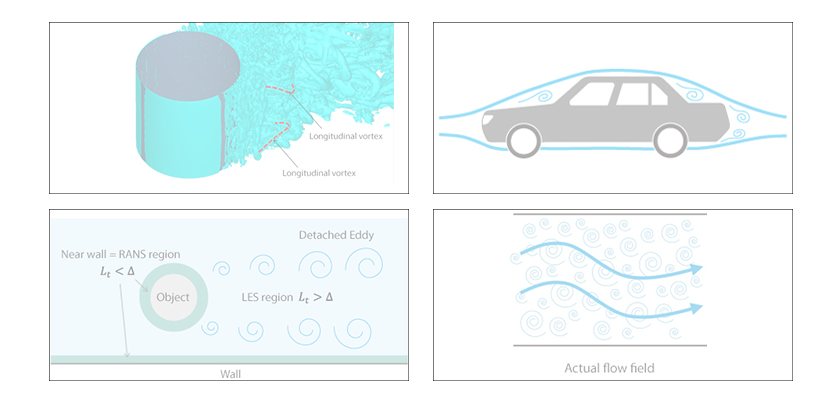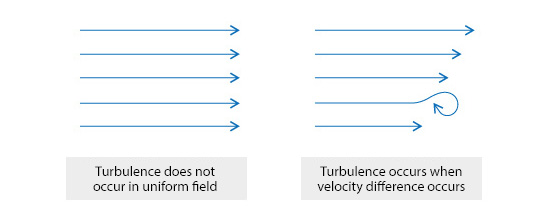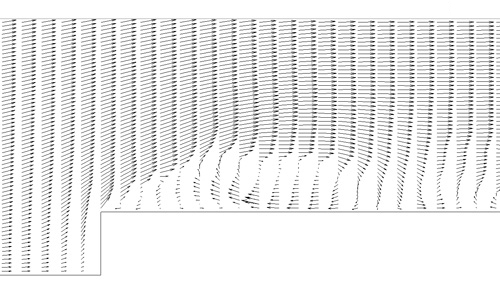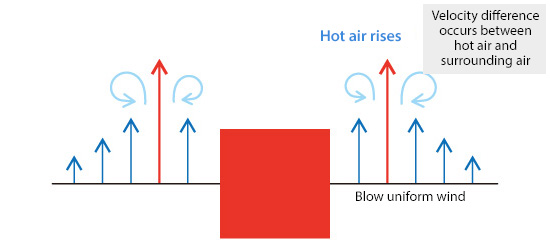Basic Course on Turbulence and Turbulent Flow Modeling 4: 4.1 How does a turbulent flow occur?

Mechanism of turbulent flow (1)
In the previous columns, we have seen the image of turbulent flows, their merits and demerits, and the relationship between turbulent flows and weather forecast. How does a turbulent flow occur? This column will introduce the mechanism of turbulent flows.
4.1 How does a turbulent flow occur?
A turbulent flow is the state where a flow is turbulent. If a flow is completely uniform (no velocity difference), turbulence does not occur. In reality, a completely uniform flow does not exist and may sound oddly for you. However, it is theoretically true. When velocity difference occurs due to some factor, turbulence occurs (Figure 4.1).

Figure 4.1: Relationship between velocity difference and turbulence
How does velocity difference occur? A typical example is a wall, which causes velocity difference. The velocity of flows near a wall slows down due to the friction resistance between the flows and wall. Then, the difference occurs between velocity of flows near the wall and that far from the wall. The friction on a wall is a major cause of turbulence of flows around objects such as an automobile. Figure 4.2 shows a calculation example of turbulence caused by velocity difference. When a flow hit a step on the floor, large velocity difference occurs and the flow becomes turbulent. Figure 4.3 shows the velocity vector map at a certain moment. You can find that eddies are formed in flows due to the smaller velocity near the wall.
Figure 4.2: Calculation example of turbulence caused by velocity difference near a wall

Figure 4.3: Velocity vector at cross section
To understand the occurrence of turbulence due to velocity difference, imagine two persons walking hand in hand (Figure 4.4). When they walk at the same velocity, they walk together without any problem. When one of them suddenly stops or starts walking at a higher velocity and they keep holding their hands, the body of the other person is rotated. In the same manner, when the velocity of a flow at a certain point becomes small or large, the surrounding flows rotate and form eddies. In addition, it is easily imagined that when two persons walk at a higher speed and one person stops, the other person is rotated with larger momentum. In the same way, when flow velocity is larger, the turbulence intensity becomes larger. Reynolds number is the index of a turbulent flow. When Reynolds number is large, a flow is regarded as turbulent. When flow velocity and momentum (inertia) are large, Reynolds number is large. Imagine that two persons running hand in hand at a high velocity and one of them suddenly stops. You can easily understand why larger Reynolds number indicates larger turbulence.

Figure 4.4: Effect of velocity difference of walking persons
Another factor to cause velocity difference is buoyancy. As shown in Figure 4.5, when a hot object is in the air and the surrounding air is warmed up, the air is accelerated in the opposite direction of gravity by buoyancy due to temperature difference. Then, velocity difference occurs between the warmed air and the surrounding cold air, and turbulence occurs. Velocity difference occurs also between the object and the warmed air. A phenomenon in which smoke rises and forms eddies has been described in the first column. The phenomenon is an example caused by buoyancy due to temperature difference. Strictly speaking about buoyancy due to temperature difference, the buoyancy is caused by unevenness of air density due to temperature difference. Therefore, difference in salt concentration in water may also cause buoyancy which results in velocity difference.

Figure 4.5: Occurrence of velocity difference and turbulence due to hot object
When eddies are generated by velocity difference in a flow at a certain point and the flow becomes turbulent, eddies are generated in a flow next to the turbulent flow. As a result, turbulence spreads in flows. Turbulence calls turbulence. The next column will introduce “The mechanism of turbulent flow (2)”.

About the Author
Takao Itami | Born in July 1973, Kanagawa, Japan
The author had conducted researches on numerical analyses of turbulence in college. After working as a design engineer for a railway rolling stock manufacturer, he took the doctor of engineering degree from Tokyo Institute of Technology (Graduate School of Science and Engineering) through researching compressible turbulent flow and Large-Eddy Simulation. He works as a consulting engineer at Software Cradle solving various customer problems with his extensive experience.


